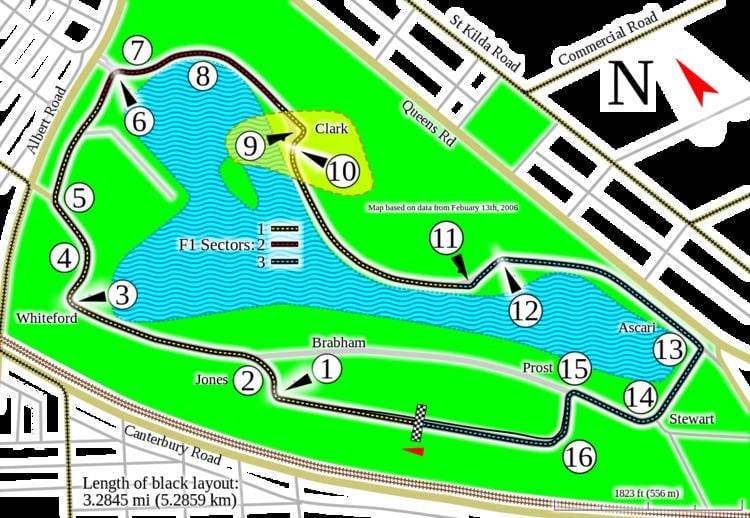Date 10 March 1996 | Course length 5.302 km (3.295 mi) | |
 | ||
Course Temporary street circuit Distance 58 laps, 307.516 km (191.110 mi) Weather Dry with temperatures reaching up to 23 °C (73 °F) | ||
The 1996 Australian Grand Prix was a Formula One motor race held on 10 March 1996 at Melbourne. It was the first time this race was held in Melbourne since 1984, taking over from Adelaide as the host of the Australian Grand Prix. It was the first time the Australian World Championship round had been held at the site of a previous Australian Grand Prix venue, albeit on a vastly different circuit, with the surrounds of the Albert Park Lake having played host to the Australian Grand Prix in 1953 and 1956. This was the debut race of the future world champion Jacques Villeneuve.
Contents
Background
This was second grand prix in a row held in Australia, the previous race being the conclusion to the 1995 season.
Taki Inoue was scheduled to race for the Minardi team as a pay driver but when no money materialised prior to the race he was replaced by Fisichella. Marlboro had expressed interest in Fisichella running early on.
The race was the first to use the new race-start system, still used in Formula 1 today, replacing the old red to green light system. Under the new system, five red lights would come on at one second intervals, starting after the last driver reached his grid box. There would then be a pre-determined pause, and then the five lights would go off simultaneously. This system was partially designed to try to eliminate some of the problems caused by drivers stalling on the grid, which in the past, had often led to start line crashes.
This was also the first race to have a single qualifying session on Saturday afternoon; the Friday session had been dropped for 1996.
Qualifying
Jacques Villeneuve, making his début in Formula One, took pole position.
Both Fortis did not make the race due to the new 107% rule for qualifying, which said any car that qualified 107% slower than the pole time (1:38.837 in this race) would be excluded. Incidentally, the team had logged its best result of 7th one race ago at the season-ending 1995 Australian Grand Prix
The measure was introduced to ensure teams were fast enough to race, and not just mobile chicanes.
Race
It was an all-Williams front row with Damon Hill and debutante Jacques Villeneuve in the blue and white Rothmans cars. In the first corner Hill was squeezed by Irvine and got a little out of shape which meant that he lost his momentum and was overtaken by both Ferraris in the run down going into the third corner. Behind Hill, Alesi sliced across in front of Hakkinen and Barrichello to claim the corner and began a chain reaction of heavy braking as drivers tried to avoid clonking one another. This was fine until the pedal-stamping reached Coulthard. The McLaren suddenly turned left and went across the road into the side of Herbert's Sauber. Herbert tried to avoid the car and braked heavily but behind him Martin Brundle was unable to check his progress. The Jordan driver tried to stop but made contact with the rear of both Herbert and Coulthard, and had a spectacular barrel roll into a sand trap at turn 3 where the car actually broke in two, causing the race to be restarted. Brundle was unhurt. David Coulthard's McLaren and Johnny Herbert's Sauber—both cars Brundle ran into the back of and launched off—were also damaged.
Brundle and Coulthard started the restarted race in their backup cars from the pits; Herbert did not take the restart, the spare car being taken by Heinz-Harald Frentzen, whose car had stopped on the warm-up lap with a technical problem. This time the Williams boys got away well and Hill was unchallenged by the Ferraris as they dived into the first corner. Gerhard Berger made another appalling start. On the second lap Schumacher slipped past Irvine and set off after the Williams boys, Villeneuve leading Hill. For the rest of the afternoon the pair would dominate. [1]
Brundle later spun off after light contact with Pedro Diniz at the restart. Schumacher did a good job to hold on, but he never really looked like challenging for the lead. On a two-stop race pattern, Schumacher dropped back half a minute with his stop - although he remained in third place until lap 28 when a brake problem sidelined him. That left Irvine in third.
The race was marked by dominance from Jacques Villeneuve, who led most of the race but had his debutante run marred by an oil leak late in the race. Hill caught and passed Villeneuve, who caked Hill's car with oil leakage.
Hill took his 14th Grand Prix victory, equaling his father Graham's overall number of wins. Hill took back to back Australian victories, the previous race being the last round of 1995, in Adelaide. In the end, the podium was Hill-Villeneuve-Irvine.
